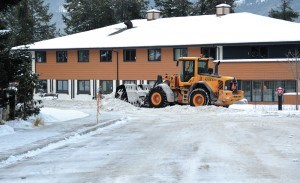
The snow from this month’s snowfall has mostly disappeared from Jasper’s streets, thanks largely to the work of the municipality’s snow removal crew.
The snow removal game is a complicated one, and often has crews on the ground battling changing weather at the same time they’re trying to predict and budget for the next storm.
The evidence of that is clear in the 2014 municipal budget, which shows that crews spent $140,292 fighting to keep the roads clear.
That money paid the salaries of the three full-time operators that work on the roads, as well as the three full-time operators that clear sidewalks.
It paid for the upkeep of the municipality’s grader and loader, both of which are equipped with a plough, two dump trucks, and the two tractors and Bobcat used to clear public sidewalks.
It also paid for the contracted services the municipality hires to help out when a big storm hits.
Bruce Thompson, the municipality’s director of operations, said that budgeting for snow removal is a difficult task, because so many factors dictate not just how he responds to snow, but how much cleanup is required.
Environment Canada’s records for Jasper measure precipitation, but don’t differentiate between rain and snow. In 2014, during the six “winter” months that Thompson uses loosely to calculate the winter snow removal budget (January, February, March, October, November and December), 142.2 millimeters of precipitation fell.
That same year the municipality spent $140,292 on snow removal, which results in $986.50 spent for each millimeter of precipitation that fell during those months last year.
Those numbers should be taken as the generalizations that they are because, as Thompson pointed out, the cost of clearing snow is anything but a simple calculation.
For one thing, the snow removal season doesn’t directly follow the budget year. Last year the municipality put aside $75,000 for winter snow removal, for the first time splitting its $150,000 road maintenance budget into two seasonal budgets. Thompson explained that that money needs to be split between the beginning and end of the calendar year.
It would be easy to blow the whole budget cleaning things up at the start of the year, but the budget needs to last until the end of the year, meaning snow fighters have to be careful how they spend.
“So say we get a bad snow day at the end of March, do we spend the dough and clear it all off, or do we save for October, November and December, not knowing what’s coming?” Thompson asked.
It’s not an easy question to answer, but generally near the end of the season crews will become a little more frugal, trusting Mother Nature to do some of their clearing for them, in order to ensure enough money remains.
“But we always have to maintain a safe transportation network, no matter what,” Thompson said.
There is also a major logistical effort behind keeping the roads and sidewalks clear that extends far beyond the hours when snow is actually falling from the sky.
Jasper’s snow removal crews operate on a priority system, clearing the most important emergency routes first, and commercial and residential ones as time and resources permit.
This means that roads leading to the police and fire stations, as well as the major arteries through town, are always cleaned first. Second comes commercial routes centred in the downtown core, followed by major residential streets. The crew gets to the rest of the town when it has the time.
According to Gord Hutton, the municipality’s fleet and public works manager, the first priority is to make the roads passable. That means clearing high-priority routes enough that vehicles can pass through, and possibly leaving cleanup for later, after other roads have been cleared.
This method often results in “windrows”—the piles of snow down the centre of recently cleared roads. Hutton explained that depending on the weather those windrows might not be cleaned up for days, because workers have to continuously return to high priority streets to keep them clear.
“At the start of this month we did the [priority] ones three times in a week, because it just kept snowing every other day,” he said. If, because of their priorities, windrows aren’t cleaned up for a few days, they can harden and become much more difficult to remove, increasing costs and taking more of the crew’s time.
Thompson explained that there are different clearing “modes” the crews go into, depending on the weather.
“We do whatever the weather demands. We can’t just sit around and hope for better weather … you have to go with what’s in front of you.
“If it’s going to be a prolonged, medium-intensity, long, drawn-out blizzard, we’ll open the roads and make them passable, but we’ll delay our final cleanup until the storm’s abated. And then you just get started on your cleanup, and then you get hit again, and you have to go back to your priority ones.”
Hutton pointed out that events in town also change priorities for snow removal. In the lead up to the Jasper in January Street Party, for example, crews prioritized clearing Patricia Street enough to accommodate foot traffic. Last weekend there were also two funerals, so Hutton said he made sure to have the cemetery parking lot clear.
“It’s not different than shoveling your walk,” Thompson said of keeping the town’s roads clear. “How do you predict when you shovel your walk? Am I just going to make it passable and then get to work and come back because it’s going to snow for the rest of the day? Would I do all of it now, or should I wait?”
This year the municipality has set aside $100,000 in its operations budget for snow removal.
Thompson said he keeps his own sidewalk nice and clear, and is confident those funds will allow him to do the same with the town’s roads.
Trevor Nichols
[email protected]
